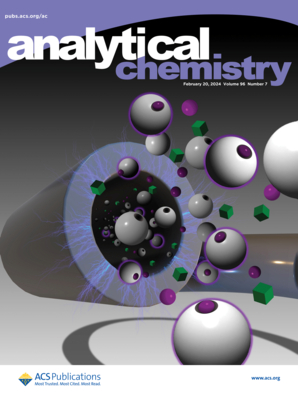On-Demand Injection of Microfluidic Droplets Based on Three-Dimensional Visual Feedback Control for High Volume Consistency and Precise Additive Concentration.
IF 6.7
1区 化学
Q1 CHEMISTRY, ANALYTICAL
引用次数: 0
Abstract
Precise and quantitative fluid addition is essential for maintaining consistency in volume and concentration across various applications including pharmaceuticals, food production, and biochemical research. Microfluidic droplet technology has emerged as a versatile microreactor for manipulating nanoliter- to picoliter-scale droplets, offering advantages such as reduced reagent consumption, faster reactions, and enhanced sensitivity. Among these, microfluidic droplet injection technology has shown promise for precise reagent addition. However, passive droplet injection methods as well as active injection methods driven by pneumatic, electrical, and acoustic forces often suffer from volume deviation due to external disturbance. Additionally, traditional two-dimensional (2D) measurement methods overlook the droplet's three-dimensional (3D) curvature, leading to insufficient data capture and significant measurement errors. This study introduces a novel on-demand microfluidic droplet injection system integrating quantitative phase imaging (QPI) for 3D visualization serving as feedback with a dual-pressure-pulse (DPP) method for fluid actuation. Comparative experiments confirmed that our approach significantly improves injection precision, achieving a coefficient of variation (CV) of 7.03%, which represents a 4.5-fold improvement over passive methods. Dynamic response experiments further verified the system's capability to adapt to target volume changes rapidly, maintaining deviations below 2% across varying conditions. As a proof of concept, the system effectively compensates for initial volume fluctuations, ensuring consistent final droplet volumes and enabling controlled isoconcentration of selenium-containing droplets, with deviations of 1.17% and 2.5%, respectively. These findings showcase the system's potential for applications requiring stringent control of volume and concentration, such as single-cell analysis, enzyme kinetics, drug delivery, and food production.基于三维视觉反馈控制的微流控液滴按需注射高体积一致性和精确添加剂浓度。
精确和定量的流体添加对于保持包括制药,食品生产和生化研究在内的各种应用的体积和浓度的一致性至关重要。微流控液滴技术已经成为一种通用的微反应器,用于操纵纳升到皮升尺度的液滴,具有减少试剂消耗,更快的反应和增强灵敏度等优点。其中,微流控液滴注射技术在精确添加试剂方面具有广阔的应用前景。然而,无论是被动滴注方式还是气动、电、声驱动的主动滴注方式,由于外界干扰,往往会出现体积偏差。此外,传统的二维(2D)测量方法忽略了液滴的三维(3D)曲率,导致数据捕获不足和显著的测量误差。介绍了一种新型的按需微流控液滴注射系统,该系统集成了用于三维可视化的定量相位成像(QPI)和双压力脉冲(DPP)流体驱动方法作为反馈。对比实验证实,我们的方法显著提高了注射精度,变异系数(CV)达到7.03%,比被动方法提高了4.5倍。动态响应实验进一步验证了系统快速适应目标体积变化的能力,在不同条件下将偏差保持在2%以下。作为概念验证,该系统有效地补偿了初始体积波动,确保了最终液滴体积的一致,并实现了含硒液滴的等浓度控制,偏差分别为1.17%和2.5%。这些发现显示了该系统在需要严格控制体积和浓度的应用中的潜力,例如单细胞分析,酶动力学,药物输送和食品生产。
本文章由计算机程序翻译,如有差异,请以英文原文为准。
求助全文
约1分钟内获得全文
求助全文
来源期刊

Analytical Chemistry
化学-分析化学
CiteScore
12.10
自引率
12.20%
发文量
1949
审稿时长
1.4 months
期刊介绍:
Analytical Chemistry, a peer-reviewed research journal, focuses on disseminating new and original knowledge across all branches of analytical chemistry. Fundamental articles may explore general principles of chemical measurement science and need not directly address existing or potential analytical methodology. They can be entirely theoretical or report experimental results. Contributions may cover various phases of analytical operations, including sampling, bioanalysis, electrochemistry, mass spectrometry, microscale and nanoscale systems, environmental analysis, separations, spectroscopy, chemical reactions and selectivity, instrumentation, imaging, surface analysis, and data processing. Papers discussing known analytical methods should present a significant, original application of the method, a notable improvement, or results on an important analyte.
 求助内容:
求助内容: 应助结果提醒方式:
应助结果提醒方式:


